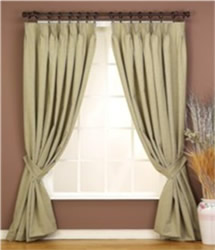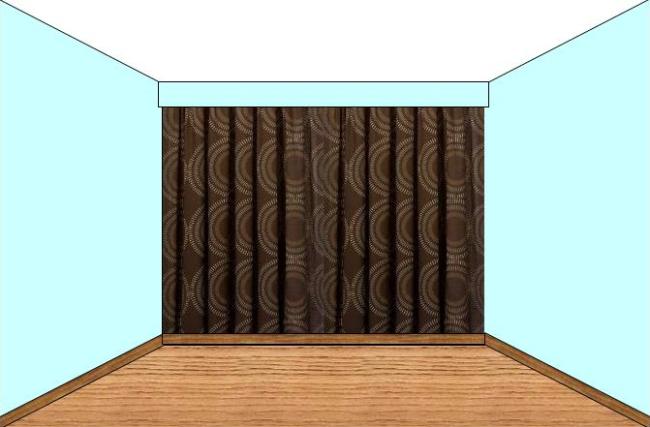
Figure 1 - Drapes pulled back over a window
Window treatments are one of the last design essentials to be thought of and drapes and curtains are no different. Drapes and curtains provide an abundance of different fabrics, colors and finished designs allow them to be customized to meet almost any window treatment requirement. However, leaving the drapes and curtains as an after-thought is a mistake, because in many cases the budget is spent on other items and there are little funds available to purchase what is needed to finish the room!
Drapes and curtains can have a tremendous influence on the apparent room design. They can be used to make a window appear larger than it actually is by installing drapes and curtains that are larger than the window both in width and/or height. As shown in Figure 2, it is impossible to determine the actual size of the window when drapes are installed wall-to-wall and ceiling-to-floor. There could even be a sliding glass door to the outside behind the drapes!

Figure 2 - Drapes installed wall-to-wall and ceiling-to-floor.
If you want to highlight a window, you can use heavy drapes in a different color then the wall, to create a visual frame around the window, as shown in Figure 1.
If you would prefer to have a specific window blend into the wall, use drapes with a light fabric that closely matches the wall colors.
Using colors within the drapes or curtains for throw cushions and other pieces of furniture will blend the drapes or curtains into the room and provide a link to all the other room's decor.
Custom-Made Drapes & Curtains Versus Ready-Made Drapes & Curtains:
As the drapes and curtains are a very important focal point of the room, decorators will generally suggest that they be custom-made. However, if you have a good sewing machine, space and are reasonably adept at using a needle and thread, it is possible to fabricate your own drapes and curtains at a fraction of the price of custom made drapes and curtains. There are many self-help sewing books available.
Ready-made drapes and curtains are generally lighter in fabric weight than what is available in custom-made drapes and curtains. As well, in many cases it is necessary to purchase drapes or curtains or multiple drapes or multiple curtains that are "close" to the size required rather than having drapes or curtains custom-made to fit the window and wall precisely. Nine foot ceilings can present a real selection problem with ready-made drapes. Many ready-made drapes and curtains are not lined and as they are mass manufactured the quality of the workmanship is usually less than what one would receive from a custom-made drapery facility.
The quality level usually makes itself quite apparent when you have the drapes or curtains cleaned. That being said there are many ready-made drapes and curtains available and they are generally less expensive than custom-made. With drapes and curtains, you generally get what you pay for.
Choosing Fabric For Your Drapes & Curtains:
By going with custom-made drapes or curtains, that you purchase or create yourself, you will be choosing the fabric and hence, the fabric can be used in other portions of the room's decor such as throw-cushions, sofa and chair coverings.
An area which is often neglected is the appearance of the drapes and curtains, from the exterior of the home. By purchasing custom-made drapery you can ensure that linings match and create curb appeal when viewed from the exterior of your home.
Drapes & Curtains - Lining:
Often forgot or neglected is the importance of the lining of the drapes and curtains. Lining your drapes and curtains not only enhances the appearance of the drapes and curtains by allowing the drapes and curtains to hang smoothly, it protects the drapes and curtains, other fabrics, flooring and the overall decor in the room from damaging UV rays. A lining on the drapes and curtains also provides the blockage of unwanted light entering from the outside of the home and prevents the room's occupants from seeing the actual window size when the drapes and curtains are closed.
The most popular colors for linings for drapes and curtains are white and ivory. Your color choice should be based on exterior co-ordination and visual enhancement. Matching drape and curtain lining color to window shades. blinds, shutters and/or exterior trim.
Besides color you will have a choice of the lining weight for the drapes and curtains.
- Lightweight drape and curtain linings include man-made fabrics such as Bancrease which is a blend of cotton and polyester. If you have chosen a heavy fabric for your drapes then a lightweight lining is usually sufficient to provide UV protection. Using heavyweight linings on heavy drapery material can cause screws to pull out of drapery rod and drapery track brackets.
- Bancrease is an excellent choice as a lining for swaged drapes or curtains. Its lightweight allows the lining to come back to shape and hang properly if and when the swag is released. Bancrease is not considered to be a blackout lining as some light will penetrate it.
- Medium weight linings include man-made fabrics such as Thermafoam®. Thermafoam® is a blend of 70% polyester and 30% cotton that feels rubbery to the touch. A medium weight lining can be used with most fabrics used for drapes and curtains.
- Thermafoam® is not considered to be a blackout lining as some light will penetrate it.
- Heavyweight linings include man-made fabrics such as Eclipse. Eclipse is also a cotton and polyester blend and is considered to be a blackout lining because it prevents the intrusion of any and all light.
- Because of the added weight it will give to the finished drapes and curtains, it is important that drapery track and rods be properly and firmly installed.
- If you are installing sheers, it is most common to use the same sheer material as the lining for the finished drapery.
Interlining:
Interlining is the placing of a fabric, usually cotton, between the material used for the drapes or curtains and the lining. Interlining your drapes or curtains helps reduce light penetration, aids in the smooth and graceful hanging and provides a thermal insulation value to the draperies.
